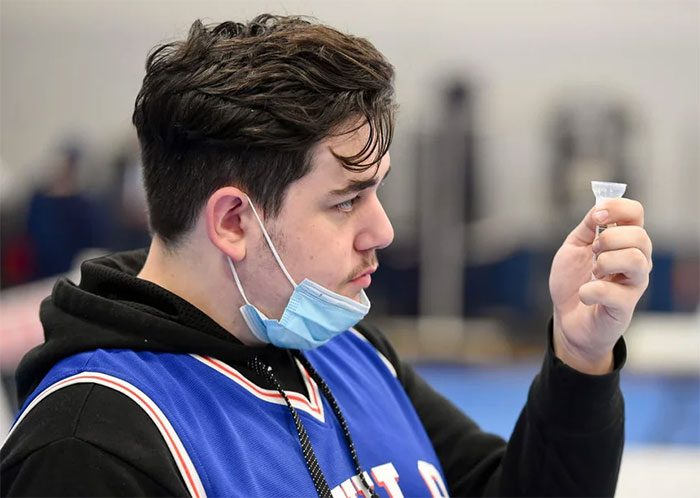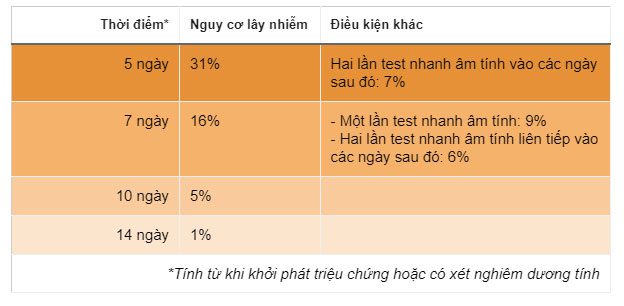This is a persistent question for many individuals who have contracted COVID-19 (referred to as F0) when they wish to reunite with friends and family. They wonder how long they should self-isolate to ensure they no longer pose a risk of transmitting the virus to others.
To date, this remains a challenging question with no consensus among countries or studies. The emergence of the Omicron variant has led to further adjustments in regulations.
Contradictory Regulations
In the United States, health officials allow most individuals infected with the coronavirus to end their isolation after 5 days without needing a COVID-19 test. This stands in contrast to the United Kingdom – where those infected with COVID-19 can go out on the sixth day, provided they have a negative test result in the last two days of isolation and are not experiencing fever. If there is no test result, they must wait a full 10 days of isolation.
Each of these decisions has been made by policymakers based on a balance between restricting movement and economic development. Dr. Anthony Fauci, the leading infectious disease expert in the U.S., stated that the isolation guidelines in the country are designed to ensure that people can return to work as soon as possible.
However, some epidemiology experts in both the UK and the U.S. have warned that isolation guidelines not grounded in science could inadvertently lead to patients spreading the virus in workplaces and schools, especially if they have not been tested.
Professor Robert Wachter, Chair of Medicine at the University of California, San Francisco, shared on Twitter on January 14 that his son tested positive on the 10th day. Without testing, he would return to work the very next day.

Each person has a different ability to eliminate the virus; therefore, their duration of infection also varies. (Photo: Ben Hasty/MediaNews Group/Reading Eagle).
Infection Risks Vary Among F0
According to data from the UK Health Security Agency, nearly 35% of F0 are still at risk of transmitting the virus after 5 days from the onset of symptoms or a positive test result. If a patient has a negative rapid test result on the 5th and 6th days of isolation, the risk of transmission is 7%. After 10 days, this number drops to 5%.
Molecular immunologist Professor Gary McLean from London Metropolitan University stated in an interview with Insider: “Individuals infected with COVID-19 can still be infectious two days before and after 10 days from the onset of symptoms.” He also noted that while it is likely that F0 will not be infectious after the health agency’s recommended period, this is not 100% safe.
“The immunity and viral load of each patient can determine how long they remain capable of transmitting the virus. Each person has different parameters,” he explained.
Additionally, the aforementioned estimates do not apply to the Omicron variant. According to virologist Professor Lawrence Young from the University of Warwick, at the time the data was published, there was not much information on the virulence of Omicron compared to other variants. Therefore, they cannot predict accurately the transmissibility of someone infected with this variant.
Both Young and McLean agree that the data provided by the UK Health Security Agency is the best available information to assess someone’s infectious potential. However, they also believe that this data may not apply to every case.
Below is the data table provided by the UK Health Security Agency:

Another study from the University of Exeter published in the International Journal of Infectious Diseases found that 13% of 176 individuals still had infectious viral particles on day 10. For some, the virus remained “alive” in their bodies for up to 68 days. This study was conducted before Omicron became the most prevalent variant globally.
Meanwhile, experts from the London School of Hygiene and Tropical Medicine indicated that the risk of transmitting the virus to others is nearly zero for F0 if they have at least two consecutive negative COVID-19 test results. This is independent of the number of days since the positive test.
In addition to the aforementioned data, several other studies from Japan and the U.S. have also examined the transmissibility of individuals infected with the Omicron variant over time.
A study involving 21 individuals in Japan found that patients vaccinated against COVID-19 who were infected with the Omicron variant and required hospitalization had the highest viral loads between days 3 and 6 after testing positive or showing symptoms. After 10 days, no infectious viral particles were detected.
Preliminary research from the U.S. indicated that both Omicron and Delta infections had a transmission period lasting approximately 10 days. Additionally, those infected with Omicron had a lower peak viral load.



















































